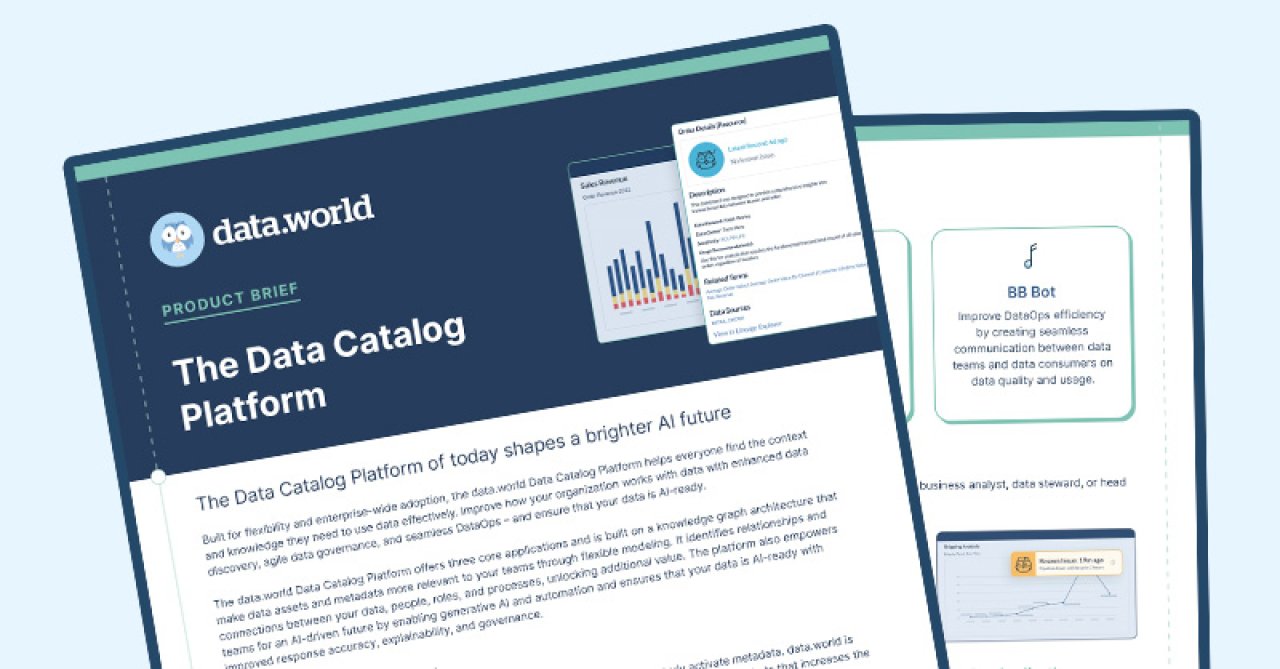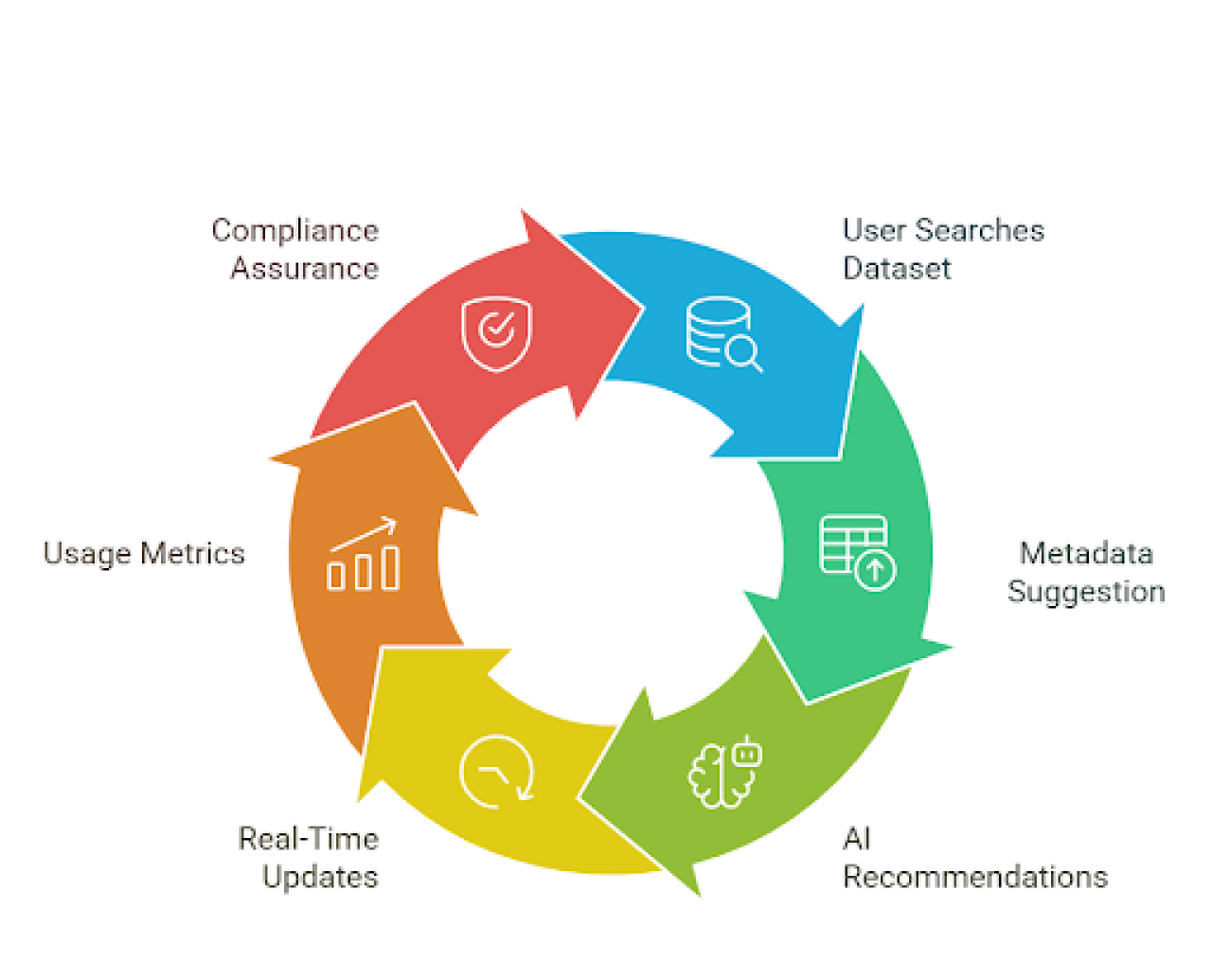







Mar 20, 2025

Liz Elfman
Content Marketing Director

Active metadata management keeps your data up-to-date without the manual hassle. Unlike traditional metadata, which sits still and gets outdated, active metadata works in the background to organize, update, and enrich your data in real time. Here’s what makes it stand out:
It collects metadata automatically and enriches it without manual intervention.
It syncs metadata dynamically so you always have the latest view of your data’s history and usage.
It uses machine learning to analyze metadata and recommend relevant datasets and detect anomalies.
These characteristics improve workflows and decision-making. For example, a retail company can use active metadata to track pricing changes and customer purchase trends in real time. This would help them adjust prices on the fly and optimize inventory effortlessly.
We’re drowning in data. In only two years alone, we’ve contributed to 90% of the world’s data — 149 zettabytes in 2024. That’s what we call data sprawl — an overwhelming amount of data that makes it harder to find and manage what really matters.
On top of that, siloed systems lock valuable data in different systems, which hinders teams from getting a complete picture. And traditional metadata management only adds to the problem.
All these challenges create hurdles and waste time searching for data and making poor decisions. To stay competitive, businesses need active metadata — it automates data collection to help teams find what they need without manual work. They even embed metadata into workflows as it makes collaboration easier and decisions more informed.
Active metadata management systems make data more dynamic and valuable with these key features:
Real-time metadata updates: Instead of relying on static, outdated records, active metadata updates everything in real time, so you’re always looking at the latest version of your data. That means better decisions with less guesswork.
Automation: Through machine learning and workflow triggers, active metadata systems reduce the need for manual metadata management. They automatically classify, tag, and enrich data to save time while increasing accuracy.
Integration: It connects smoothly across multiple tools and platforms to create a unified metadata layer. This removes data silos and provides a more holistic view of data assets across the organization.
Actionability: It turns metadata into insights that drive action through features like data lineage visualization or automated governance. This helps teams understand data dependencies and assess risks, based on which they can make appropriate decisions faster.
Active metadata adds value across many real-world scenarios to help businesses manage data more effectively. Let’s look at some common examples of how it does this:
A financial services company can use active metadata to automatically flag sensitive customer data like PII to comply with GDPR and HIPAA regulations. That’s why only authorized users can access protected data without the risk of breaches and fines.
In retail, active metadata can detect anomalies in sales reports by identifying duplicate entries and missing records. This helps teams correct data inconsistencies before they impact business decisions.
Marketing teams searching for campaign performance data can use AI-driven recommendations for relevant datasets based on their queries and past usage. This saves time on manual searching and empowers non-technical users to analyze data confidently.
Healthcare providers can trace data across multiple systems to see how patient records flow from data entry to reporting. If a discrepancy arises, active metadata enables quick impact analysis and troubleshooting to give more details into patient care.
Active metadata management constantly processes and connects metadata to make it more useful and actionable. Here’s how it works:
Metadata is automatically collected from data sources like databases, analytics platforms, data pipelines, and APIs. This keeps it up to date as data changes across systems.
AI and machine learning tag and enrich the metadata with insights to show data relationships, usage patterns, quality metrics, and governance rules. This makes the metadata clearer and easier to understand.
The enriched metadata is embedded into workflows, so users get real-time insights without leaving their usual processes.
Here’s how you can think of this whole process: Suppose a data analyst is looking for customer sales data in a company’s data catalog. Instead of manually searching through hundreds of datasets, the system suggests the most relevant and trusted ones based on past user behavior.

The analyst also gets AI-driven recommendations for related datasets and alerts about potential data quality issues. Because the metadata updates in real time, they can see accurate usage metrics and ensure compliance which makes the whole process smoother and more reliable.
Active metadata management comes with its challenges, but the right tools and strategies can make it much easier. Let’s understand these challenges and their solutions.
Integrating metadata across multiple systems isn’t easy — different formats and architectures don’t always play nicely together. Since different platforms use incompatible formats, schemas, and architectures, you cannot efficiently standardize and synchronize metadata.
To avoid this, use interoperable data cataloging platforms that support open APIs and automated connectors — this will require less manual integration efforts.
It’s normal to feel hesitant about switching to active metadata — change can feel overwhelming, and new tools take time to get used to. In fact, 83% of employees struggling with change fatigue don’t have the right tools, which overwhelms them and leaves them unprepared.
They do not realize the full potential of automating active metadata management but rather focus on the tedious process of shifting from traditional methods to a new approach. But once teams see how much easier it makes their day-to-day work, they won’t look back.
That’s why you must invest in clear communication and hands-on training to drive adoption. This will make it easy to demonstrate how modern management processes provide quick wins and task simplification compared to traditional methods.
Active metadata management needs a strong foundation to succeed. But many organizations try to implement it before getting the basics right. A complete data inventory is the first step — it documents all data assets across the business with enough context to make them useful.
Rushing into active metadata without this groundwork often creates problems. Gaps in asset coverage and poor metadata quality can all undermine the system. And when active metadata is built on weak cataloging, those flaws spread throughout the data ecosystem and may break trust in the tools meant to improve data understanding.
To overcome these challenges, choose scalable, AI-powered cataloging solutions that automate metadata collection and enrichment. They easily maintain an active metadata strategy without excessive manual effort. And when active metadata has the right foundation, teams can work much faster. Gartner says companies using it could cut the time it takes to deliver new data assets by up to 70%.
Over half of respondents in a data-related survey reported that 25% or more of their revenue was impacted by data quality issues. One primary reason behind this is traditional data management approaches, which create redundancy.
Traditional data catalogs need manual updates, which often leave records outdated. AI-powered catalogs, on the other hand, automate metadata tagging, which keeps data updated and delivers more accurate business insights in real time.
A flexible, knowledge-graph-powered catalog further amplifies metadata by dynamically linking data assets and business context. So if you are searching for the right data catalog, make sure it has these key features:
Continuously ingests metadata from multiple sources to get real-time accuracy without manual effort.
Uses machine learning to enhance metadata by automating tagging, classification, and context-building.
Allows users to visualize how data flows across systems and instantly assess the impact of changes for better governance and quicker troubleshooting.
Provides built-in collaboration and knowledge-sharing tools to help teams work together efficiently and preserve metadata quality.
Watch this podcast episode where Mike Evans explains how modern data catalogs like data.world transform metadata from a passive record into an intelligent, action-driven asset.
Emerging technologies and approaches are improving active metadata management for efficient and intelligent data operations with time. Here are some key trends that are expected to rise even further in the future:
AI is making metadata more accessible. It can now explain complex database elements like SQL views (predefined queries), Snowflake policies (access rules), and dbt models (data transformation workflows) so users don’t have to dig through code themselves. With just one click, it writes clear descriptions for tables, columns, and key business terms which saves data teams a lot of time.
Instead of struggling with complex search syntax, we can now ask questions in plain English, and AI will fetch the correct answers. Beyond search, it suggests questions a dataset might answer to help people find insights they may not have thought of.
This means that anyone, not just data analysts, can understand data and make data-driven decisions.
Dave Griffith, a software engineer at data.world, shares how OpenAI’s large language models (LLMs) transform the way teams interact with their data.
Active metadata management is now bringing metadata-driven automation into DataOps and MLOps. DataOps streamlines data pipelines to maintain data quality and availability, while MLOps applies these principles to deploying and managing machine learning models. By integrating active metadata into these workflows, you can track trends and continuously transform data into high-quality assets.
Take Adobe, for example. The company recently launched a web app to upgrade its Content Credentials system, which helps creatives protect their work and ensure proper attribution. This tool embeds metadata such as creator details, ownership, and AI usage directly into online content.
Because this metadata is tamper-evident, it provides transparency and authenticity so viewers can verify the origin and modifications of the content. As a result, artists’ rights are better protected, and AI-generated or manipulated media can be identified more easily.
Active metadata management uses emerging technologies to optimize data operation through automation and self-service capabilities. It brings in agentic AI that can take care of data quality on its own, so you don’t have to manually check everything. It also checks and fixes data quality to make sure everything stays accurate and compliant — even at scale.
With AI and machine learning, active metadata automates several metadata management tasks more accurately. This continuous, real-time approach provides deep insights into data usage and governance, giving organizations enough insight to make better decisions.
But you must adopt the best practices to gain a competitive advantage and create a modern data strategy. So instead of relying on traditional repositories, use data.world’s modern data catalog to track and activate metadata and reap its full potential.
data.world’s approach to active metadata perfectly aligns with the principles and benefits of modern metadata management. Our AI-driven catalog automates metadata collection, tagging, and classification. It continuously processes metadata to provide real-time insights into data usage which helps organizations break down data silos and make better decisions.
Want to turn metadata into a powerful, action-driven asset? Book a demo to see how data.world’s catalog can help you scale your data strategy.

Active metadata management keeps your data up-to-date without the manual hassle. Unlike traditional metadata, which sits still and gets outdated, active metadata works in the background to organize, update, and enrich your data in real time. Here’s what makes it stand out:
It collects metadata automatically and enriches it without manual intervention.
It syncs metadata dynamically so you always have the latest view of your data’s history and usage.
It uses machine learning to analyze metadata and recommend relevant datasets and detect anomalies.
These characteristics improve workflows and decision-making. For example, a retail company can use active metadata to track pricing changes and customer purchase trends in real time. This would help them adjust prices on the fly and optimize inventory effortlessly.
We’re drowning in data. In only two years alone, we’ve contributed to 90% of the world’s data — 149 zettabytes in 2024. That’s what we call data sprawl — an overwhelming amount of data that makes it harder to find and manage what really matters.
On top of that, siloed systems lock valuable data in different systems, which hinders teams from getting a complete picture. And traditional metadata management only adds to the problem.
All these challenges create hurdles and waste time searching for data and making poor decisions. To stay competitive, businesses need active metadata — it automates data collection to help teams find what they need without manual work. They even embed metadata into workflows as it makes collaboration easier and decisions more informed.
Active metadata management systems make data more dynamic and valuable with these key features:
Real-time metadata updates: Instead of relying on static, outdated records, active metadata updates everything in real time, so you’re always looking at the latest version of your data. That means better decisions with less guesswork.
Automation: Through machine learning and workflow triggers, active metadata systems reduce the need for manual metadata management. They automatically classify, tag, and enrich data to save time while increasing accuracy.
Integration: It connects smoothly across multiple tools and platforms to create a unified metadata layer. This removes data silos and provides a more holistic view of data assets across the organization.
Actionability: It turns metadata into insights that drive action through features like data lineage visualization or automated governance. This helps teams understand data dependencies and assess risks, based on which they can make appropriate decisions faster.
Active metadata adds value across many real-world scenarios to help businesses manage data more effectively. Let’s look at some common examples of how it does this:
A financial services company can use active metadata to automatically flag sensitive customer data like PII to comply with GDPR and HIPAA regulations. That’s why only authorized users can access protected data without the risk of breaches and fines.
In retail, active metadata can detect anomalies in sales reports by identifying duplicate entries and missing records. This helps teams correct data inconsistencies before they impact business decisions.
Marketing teams searching for campaign performance data can use AI-driven recommendations for relevant datasets based on their queries and past usage. This saves time on manual searching and empowers non-technical users to analyze data confidently.
Healthcare providers can trace data across multiple systems to see how patient records flow from data entry to reporting. If a discrepancy arises, active metadata enables quick impact analysis and troubleshooting to give more details into patient care.
Active metadata management constantly processes and connects metadata to make it more useful and actionable. Here’s how it works:
Metadata is automatically collected from data sources like databases, analytics platforms, data pipelines, and APIs. This keeps it up to date as data changes across systems.
AI and machine learning tag and enrich the metadata with insights to show data relationships, usage patterns, quality metrics, and governance rules. This makes the metadata clearer and easier to understand.
The enriched metadata is embedded into workflows, so users get real-time insights without leaving their usual processes.
Here’s how you can think of this whole process: Suppose a data analyst is looking for customer sales data in a company’s data catalog. Instead of manually searching through hundreds of datasets, the system suggests the most relevant and trusted ones based on past user behavior.

The analyst also gets AI-driven recommendations for related datasets and alerts about potential data quality issues. Because the metadata updates in real time, they can see accurate usage metrics and ensure compliance which makes the whole process smoother and more reliable.
Active metadata management comes with its challenges, but the right tools and strategies can make it much easier. Let’s understand these challenges and their solutions.
Integrating metadata across multiple systems isn’t easy — different formats and architectures don’t always play nicely together. Since different platforms use incompatible formats, schemas, and architectures, you cannot efficiently standardize and synchronize metadata.
To avoid this, use interoperable data cataloging platforms that support open APIs and automated connectors — this will require less manual integration efforts.
It’s normal to feel hesitant about switching to active metadata — change can feel overwhelming, and new tools take time to get used to. In fact, 83% of employees struggling with change fatigue don’t have the right tools, which overwhelms them and leaves them unprepared.
They do not realize the full potential of automating active metadata management but rather focus on the tedious process of shifting from traditional methods to a new approach. But once teams see how much easier it makes their day-to-day work, they won’t look back.
That’s why you must invest in clear communication and hands-on training to drive adoption. This will make it easy to demonstrate how modern management processes provide quick wins and task simplification compared to traditional methods.
Active metadata management needs a strong foundation to succeed. But many organizations try to implement it before getting the basics right. A complete data inventory is the first step — it documents all data assets across the business with enough context to make them useful.
Rushing into active metadata without this groundwork often creates problems. Gaps in asset coverage and poor metadata quality can all undermine the system. And when active metadata is built on weak cataloging, those flaws spread throughout the data ecosystem and may break trust in the tools meant to improve data understanding.
To overcome these challenges, choose scalable, AI-powered cataloging solutions that automate metadata collection and enrichment. They easily maintain an active metadata strategy without excessive manual effort. And when active metadata has the right foundation, teams can work much faster. Gartner says companies using it could cut the time it takes to deliver new data assets by up to 70%.
Over half of respondents in a data-related survey reported that 25% or more of their revenue was impacted by data quality issues. One primary reason behind this is traditional data management approaches, which create redundancy.
Traditional data catalogs need manual updates, which often leave records outdated. AI-powered catalogs, on the other hand, automate metadata tagging, which keeps data updated and delivers more accurate business insights in real time.
A flexible, knowledge-graph-powered catalog further amplifies metadata by dynamically linking data assets and business context. So if you are searching for the right data catalog, make sure it has these key features:
Continuously ingests metadata from multiple sources to get real-time accuracy without manual effort.
Uses machine learning to enhance metadata by automating tagging, classification, and context-building.
Allows users to visualize how data flows across systems and instantly assess the impact of changes for better governance and quicker troubleshooting.
Provides built-in collaboration and knowledge-sharing tools to help teams work together efficiently and preserve metadata quality.
Watch this podcast episode where Mike Evans explains how modern data catalogs like data.world transform metadata from a passive record into an intelligent, action-driven asset.
Emerging technologies and approaches are improving active metadata management for efficient and intelligent data operations with time. Here are some key trends that are expected to rise even further in the future:
AI is making metadata more accessible. It can now explain complex database elements like SQL views (predefined queries), Snowflake policies (access rules), and dbt models (data transformation workflows) so users don’t have to dig through code themselves. With just one click, it writes clear descriptions for tables, columns, and key business terms which saves data teams a lot of time.
Instead of struggling with complex search syntax, we can now ask questions in plain English, and AI will fetch the correct answers. Beyond search, it suggests questions a dataset might answer to help people find insights they may not have thought of.
This means that anyone, not just data analysts, can understand data and make data-driven decisions.
Dave Griffith, a software engineer at data.world, shares how OpenAI’s large language models (LLMs) transform the way teams interact with their data.
Active metadata management is now bringing metadata-driven automation into DataOps and MLOps. DataOps streamlines data pipelines to maintain data quality and availability, while MLOps applies these principles to deploying and managing machine learning models. By integrating active metadata into these workflows, you can track trends and continuously transform data into high-quality assets.
Take Adobe, for example. The company recently launched a web app to upgrade its Content Credentials system, which helps creatives protect their work and ensure proper attribution. This tool embeds metadata such as creator details, ownership, and AI usage directly into online content.
Because this metadata is tamper-evident, it provides transparency and authenticity so viewers can verify the origin and modifications of the content. As a result, artists’ rights are better protected, and AI-generated or manipulated media can be identified more easily.
Active metadata management uses emerging technologies to optimize data operation through automation and self-service capabilities. It brings in agentic AI that can take care of data quality on its own, so you don’t have to manually check everything. It also checks and fixes data quality to make sure everything stays accurate and compliant — even at scale.
With AI and machine learning, active metadata automates several metadata management tasks more accurately. This continuous, real-time approach provides deep insights into data usage and governance, giving organizations enough insight to make better decisions.
But you must adopt the best practices to gain a competitive advantage and create a modern data strategy. So instead of relying on traditional repositories, use data.world’s modern data catalog to track and activate metadata and reap its full potential.
data.world’s approach to active metadata perfectly aligns with the principles and benefits of modern metadata management. Our AI-driven catalog automates metadata collection, tagging, and classification. It continuously processes metadata to provide real-time insights into data usage which helps organizations break down data silos and make better decisions.
Want to turn metadata into a powerful, action-driven asset? Book a demo to see how data.world’s catalog can help you scale your data strategy.